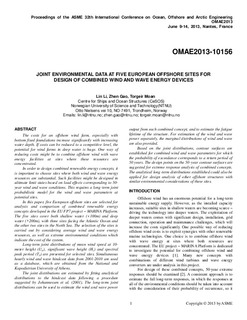| dc.description.abstract | The costs for an offshore wind farm, especially with bottom fixed foundations increase significantly with increasing water depth. If costs can be reduced to a competitive level, the potential for wind farms in deep water is huge. One way of reducing costs might be to combine offshore wind with wave energy facilities at sites where these resources are concentrated.
In order to design combined renewable energy concepts, it is important to choose sites where both wind and wave energy resources are substantial. Such facilities might be designed in ultimate limit states based on load effects corresponding to 50-year wind and wave conditions. This requires a long-term joint probabilistic model for the wind and wave parameters at potential sites.
In this paper, five European offshore sites are selected for analysis and comparison of combined renewable energy concepts developed in the EU FP7 project – MARINA Platform. The five sites cover both shallow water (<100m) and deep water (> 200m), with three sites facing the Atlantic Ocean and the other two sites in the North Sea. The selection of the sites is carried out by considering average wind and wave energy resources, as well as extreme environmental conditions which indicate the cost of the system.
Long-term joint distributions of mean wind speed at 10-meter height (Uw), significant wave height (Hs) and spectral peak period (Tp) are presented for selected sites. Simultaneous hourly wind and wave hindcast data from 2001–2010 are used as a database, which are obtained from the National and Kapodistrian University of Athens.
The joint distributions are estimated by fitting analytical distributions to the hindcast data following a procedure suggested by Johannessen et al. (2001). The long-term joint distributions can be used to estimate the wind and wave power output from each combined concept, and to estimate the fatigue lifetime of the structure. For estimation of the wind and wave power separately, the marginal distributions of wind and wave are also provided.
Based on the joint distributions, contour surfaces are established for combined wind and wave parameters for which the probability of exceedance corresponds to a return period of 50 years. The design points on the 50-year contour surfaces are suggested for extreme response analysis of combined concepts. The analytical long-term distributions established could also be applied for design analysis of other offshore structures with similar environmental considerations of these sites. | nb_NO |
